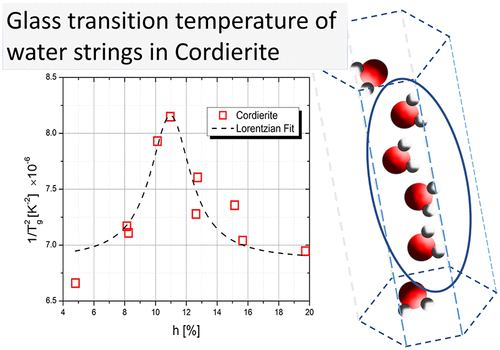当前位置:
X-MOL 学术
›
J. Phys. Chem. Lett.
›
论文详情
Our official English website, www.x-mol.net, welcomes your
feedback! (Note: you will need to create a separate account there.)
One-Dimensional Glassy Behavior of Ultraconfined Water Strings.
The Journal of Physical Chemistry Letters ( IF 4.8 ) Pub Date : 2020-08-26 , DOI: 10.1021/acs.jpclett.0c02026 Paul Ben Ishai 1 , Michelle K Kidder 2 , Alexander I Kolesnikov 3 , Lawrence M Anovitz 4
The Journal of Physical Chemistry Letters ( IF 4.8 ) Pub Date : 2020-08-26 , DOI: 10.1021/acs.jpclett.0c02026 Paul Ben Ishai 1 , Michelle K Kidder 2 , Alexander I Kolesnikov 3 , Lawrence M Anovitz 4
Affiliation

|
Water is renowned for its anomalous behaviors, which can be linked to a distributed H-bond network in bulk water. Ultraconfinement of the water molecule can remove H-bonding, leaving only molecular water. In natural cordierite crystals, water is trapped in an orthorhombic channel with an average diameter of 5.7 Å, running through the center of the unit cell parallel to the c-axis. Calorimetric measurements reveal the existence of a one-dimensional (1D) glass linked to this water. In these channels, water molecules in truncated, sparse 1D strings interact only via dipole–dipole correlations. A physical 1D glass is formed from these strings. This unusual state can be explained by a modified Ising model. This model predicts a dependence of the glass transition temperature, Tg, on the size of these domains. This is confirmed experimentally.
中文翻译:

超限水绳的一维玻璃态行为。
水以其异常行为而闻名,可以将其与散装水中的分布式H键网络联系起来。水分子的超约束作用可以消除氢键,仅留下分子水。在天然堇青石晶体中,水被俘获在平均直径为5.7的正交晶体通道中,流经平行于c轴的晶胞中心。量热法测量表明存在与该水相关的一维(1D)玻璃。在这些通道中,稀疏的一维字符串中的水分子仅通过偶极-偶极相关性相互作用。由这些细绳形成物理的一维玻璃。可以通过修改的Ising模型来解释这种异常状态。该模型预测了玻璃化转变温度T g的依赖性。,取决于这些域的大小。实验证实了这一点。
更新日期:2020-09-18
中文翻译:

超限水绳的一维玻璃态行为。
水以其异常行为而闻名,可以将其与散装水中的分布式H键网络联系起来。水分子的超约束作用可以消除氢键,仅留下分子水。在天然堇青石晶体中,水被俘获在平均直径为5.7的正交晶体通道中,流经平行于c轴的晶胞中心。量热法测量表明存在与该水相关的一维(1D)玻璃。在这些通道中,稀疏的一维字符串中的水分子仅通过偶极-偶极相关性相互作用。由这些细绳形成物理的一维玻璃。可以通过修改的Ising模型来解释这种异常状态。该模型预测了玻璃化转变温度T g的依赖性。,取决于这些域的大小。实验证实了这一点。











































 京公网安备 11010802027423号
京公网安备 11010802027423号